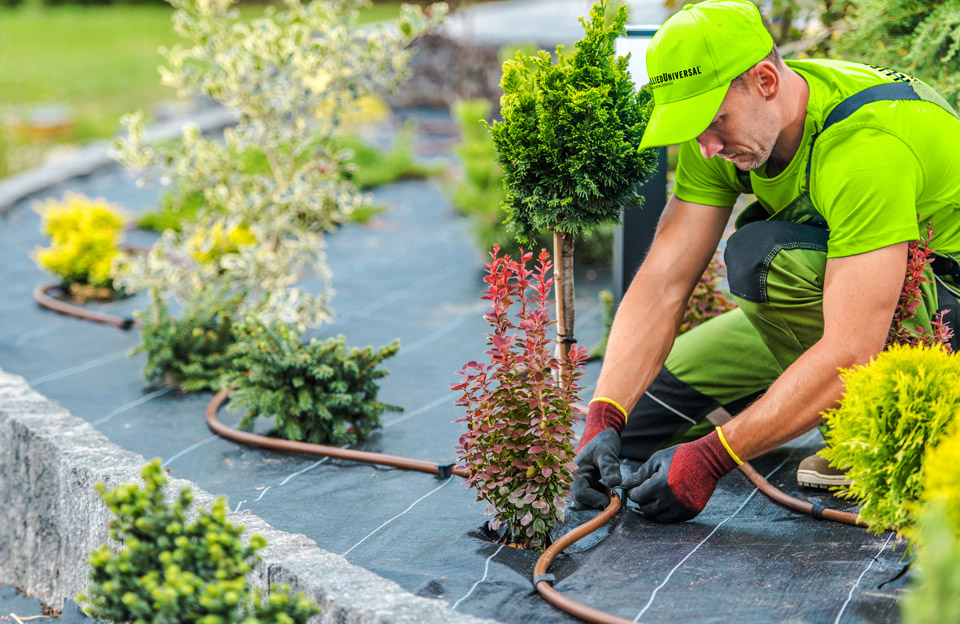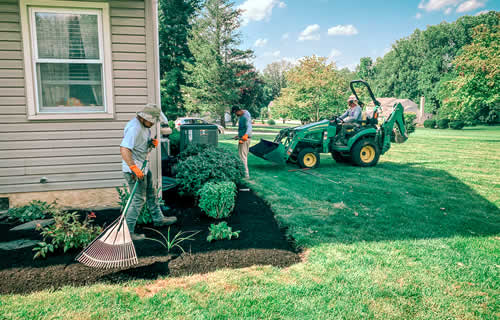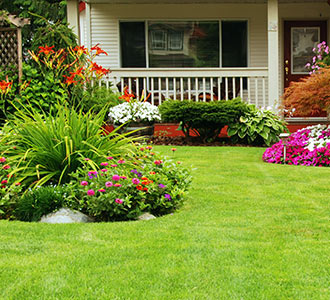Recognizing the Comprehensive Extent of Works in Specialist Landscape Design Services
The comprehensive extent of professional landscape design services encompasses a selection of fundamental elements - landscaping. It consists of landscape design concepts, plant selection, and hardscaping functions. Additionally, it attends to watering systems and upkeep methods. Each aspect plays an essential function in developing functional and aesthetically pleasing outside areas. Comprehending how these elements interact can disclose much about the art and science of landscape design. The trip into this intricate area is just starting.
Landscape Layout Concepts
Efficient landscape layout principles are important for producing harmonious exterior areas that improve both aesthetic charm and functionality (Learn More). These principles lead the plan of components within the landscape, ensuring a natural aesthetic experience. Key parts consist of balance, which distributes visual weight evenly; percentage, which connects the dimension of various components to each various other and the area; and unity, which produces a sense of wholeness via constant themes and materials

Plant Option and Installment
In the domain of specialist landscaping, plant option and setup play an important function in attaining a flourishing yard. Stressing indigenous plant advantages, seasonal considerations, and the specific dirt and sunlight demands of each varieties assures a lasting and aesthetically pleasing landscape. Careful planning in these areas not just improves biodiversity yet additionally advertises long-lasting eco-friendly health.
Indigenous Plant Benefits
Why should home owners think about indigenous plants for their landscape design projects? Indigenous plants provide numerous benefits that boost both looks and ecological sustainability. They are well-adapted to local environments, requiring much less water and upkeep compared to non-native varieties. This strength reduces the demand for chemical fertilizers and chemicals, promoting a much healthier environment. In addition, indigenous plants provide habitat and food for neighborhood wildlife, including pollinators, which can increase biodiversity in suburbs. Their familiarity with neighborhood soil and climate condition additionally causes far better growth rates and durability. By picking indigenous plants, homeowners not just create visually attractive landscapes yet additionally add to eco-friendly conservation, making a favorable effect on their local atmosphere. Consequently, native plants stand for a clever option for landscape design jobs.
Seasonal Plant Considerations
Home owners who have embraced indigenous plants in their landscape design can additionally improve their exterior spaces by taking into consideration seasonal plant options. By integrating plants that thrive in particular seasons, they can create dynamic and visually appealing landscapes throughout the year. Springtime might introduce vivid flowers like tulips and daffodils, while summertime can showcase lavish vegetation and vivid perennials. Autumn introduces a palette of cozy tones with asters and goldenrods, while winter can be emphasized with evergreens and decorative turfs for structure. Specialist landscapers commonly advise choosing plants that not only enhance existing native varieties yet additionally offer year-round rate of interest and assistance neighborhood wild animals. This thoughtful approach to seasonal plant selection guarantees a continually progressing and lasting yard setting.
Dirt and Sunshine Demands
Effective landscape design hinges on understanding the particular soil and sunlight needs of plants. Different species flourish under varying problems, calling for a cautious evaluation of both elements during the selection process. Soil types, such as sandy, clay, or loamy, impact water drainage, vitamins and mineral schedule, and root development. Furthermore, pH levels can influence plant wellness, demanding soil testing to ascertain viability. Sunshine demands vary considerably; some plants flourish completely sun, while others choose partial or full color. A professional landscaper takes into consideration these components to ensure peak growth and visual allure. By straightening plant selections with the setting's particular features, landscapes can attain sustainability, durability, and visual harmony, inevitably bring about successful plant establishment and long-lasting maintenance.
Hardscaping Attributes and Construction

While landscape design commonly evokes images of lavish plant and lively flowers, hardscaping features play an essential role in specifying outdoor spaces. These aspects, that include outdoor patios, walkways, preserving walls, and decorative stonework, provide framework and performance to yards and yards. Hardscaping uses materials such as concrete, block, rock, and timber, allowing for diverse styles that complement the natural landscape.
The building of hardscaping attributes needs cautious planning and execution to guarantee toughness and visual charm. Specialists assess website problems, water drainage, and spatial connections to develop cohesive exterior settings. Proper installment methods are crucial, as they protect against concerns like disintegration and shifting gradually.
Including hardscaping not only improves the visual interest of a home yet also helps with outside activities, making it an essential facet of comprehensive landscape design services. Eventually, thoughtful hardscaping adds to both the capability and beauty of outside rooms.
Watering Systems and Water Monitoring
Efficient watering systems and water management are crucial components of professional landscaping, as they assure that plants get the required hydration for ideal growth. These systems can vary from simple drip watering setups to innovative automated automatic sprinkler, developed to meet the particular demands of diverse landscapes. Appropriate water monitoring not just optimizes water usage, reducing waste, however additionally boosts plant health and lessens condition risks.
Landscaping experts assess various aspects, consisting of dirt type, plant species, and regional climate, to create tailored irrigation services. Furthermore, including rain harvesting strategies can further enhance sustainability and performance. Regular upkeep of watering systems is important to preserve performance and stop leakages, which can lead to water loss and enhanced costs (Learn More). Inevitably, a well-designed watering system plays an essential function in maintaining the visual appeal of exterior areas while advertising environmental stewardship within professional landscape design methods
Grass Care and Maintenance Methods
Lawn treatment and maintenance methods are fundamental for achieving a lush, healthy and balanced yard that boosts the overall landscape. These methods encompass different techniques focused on advertising optimal development and aesthetic allure. Routine mowing is essential, as it motivates thick, even growth while protecting against weeds from establishing. In addition, correct fertilization offers essential nutrients, with applications tailored to the particular turf kind and dirt problems.
Watering practices should concentrate on deep, irregular watering to urge origin development, while aeration enhances soil structure and advertises nutrient absorption. Bug and condition management is likewise essential; identifying concerns early enables efficient therapies that decrease damages.
Overseeding can renew slim or damaged grass, boosting thickness and shade (landscaping services). By implementing these targeted lawn treatment strategies, landscape design specialists can assure that backyards continue to be vibrant and healthy throughout the periods, greatly adding to the total appeal of the home
Seasonal Landscape Care and Maintenance
As the periods adjustment, appropriate landscape care becomes vital for keeping the wellness and elegance of exterior areas. Each season presents one-of-a-kind difficulties and demands. In spring, landscape specialists concentrate on trimming, growing, and fertilizing to urge development. Summer demands normal watering, weed control, and bug monitoring to shield recently established plants.

Throughout the read more year, seasonal landscape upkeep assurances that exterior locations stay aesthetically enticing and healthy and balanced. Professional services can offer customized maintenance strategies that adjust to the certain demands of each period, permitting building proprietors to enjoy vivid landscapes year-round. Overall, seasonal treatment is a vital facet of specialist landscape design that advertises durability and aesthetic value.

Lasting Landscaping Practices
An expanding number of homeowner are accepting sustainable landscaping practices to develop environmentally pleasant outdoor rooms. These practices concentrate on conserving sources, enhancing biodiversity, and lessening environmental effect. Indigenous plants are typically chosen for their low water needs and compatibility with local ecosystems, minimizing the demand for chemical fertilizers and pesticides. Rainfall yards and permeable paving are utilized to take care of stormwater overflow, advertising groundwater recharge and minimizing erosion.
Lasting landscape design incorporates organic gardening methods that focus on dirt health and promote natural insect control. Effective watering systems, such as drip watering and rain harvesting, aid maximize water usage. Additionally, landscape designers progressively promote for the usage of recycled products, such as recovered timber and stones, to reduce waste. By embracing these lasting methods, homeowner not just contribute to environmental conservation however also produce visually pleasing atmospheres that can prosper with marginal upkeep.
Often Asked Concerns
The length of time Does a Landscaping Job Usually Take to Complete?
Normally, a landscape design project can take anywhere from a few days to several weeks to finish, depending on the task's intricacy, style, and size requirements. Factors such as climate and resource availability additionally influence timelines.
What Factors Impact the Cost of Landscaping Services?
Different variables influence landscape design service expenses, consisting of task size, layout complexity, material top quality, labor costs, geographical location, and seasonal demand. Each aspect adds distinctly to the general monetary needs of a landscape design project.
Are Landscaping Solutions Available Year-Round?
Landscape design services are usually available year-round, although availability might differ based upon area, seasonal weather, and specific service offerings. Some services may be limited during extreme weather condition or off-peak periods.
Do Landscape Design Firms Deal Service Warranties on Their Job?
Several landscape design firms do supply service warranties on their work, which can vary in size and insurance coverage. Customers are urged to make inquiries concerning details terms, guaranteeing they comprehend what is ensured and any type of conditions that apply.
Can I Design My Landscape Without Professional Help?
Yes, people can make their landscapes without specialist aid. They may lack expertise in plant option, design, and environmental factors to consider, potentially leading to less effective layouts that might call for expensive adjustments later on.
In the domain of specialist landscaping, plant selection and installment play a critical duty in accomplishing a flourishing yard. House owners who have actually embraced indigenous plants in their landscaping can additionally improve their exterior areas by considering seasonal plant options. Successful landscape design hinges on recognizing the certain dirt and sunlight needs of plants. Efficient watering systems and water management are crucial elements of professional landscaping, as they assure that plants receive the required hydration for optimal development. Landscaping experts assess various elements, consisting of dirt type, plant species, and regional environment, to develop tailored irrigation options.